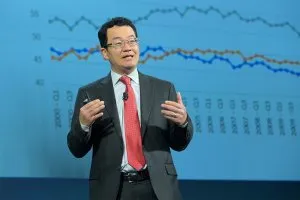The U.S. population is growing by one person every 15 seconds, according to the Census Bureau’s population clock. That’s an increase of about three dozen people in the time it takes to read this story.
But the country’s population isn’t just growing. It’s also shifting — between regions, states and cities and within them. The trends created by this ebb and flow are changing the dynamics of American demographics.
The trend that trumps all trends is the growing percentage of Americans who live in the West (23.5 percent) and the South (37.4 percent) versus the shrinking percentage who live in the Northeast (17.7 percent) and Midwest (21.4 percent).
But that’s a 10,000-foot view of where growth is occurring. When demographers zoom in for a closer look, additional patterns come into focus that show not only the relative strength of the West and South but also the relative strength of urban environments — and by extension smart growth.
As people gravitate inward toward the center of places rather than outward toward the edges, smart growth with its emphasis on focusing development where it already exists is very much in step with the march of the U.S. population.
Here are some revealing snapshots of how and where growth is occurring based on recent Census Bureau data and research by population analysts.
Cities upstaging suburbs
Historically, the suburbs within the nation’s large metro areas have grown much faster than their primary cities. Between 2000 and 2010, the suburbs grew at an annual average rate of 1.38 percent compared to 0.42 percent for primary cities.
The trend is now reversed. Between 2010 and 2013, primary cities with populations of 100,000 or more outgrew suburbs each year — 1.05 percent to 0.95 percent in 2010-11, 1.13 percent to 0.95 percent in 2011-12 and 1.02 percent to 0.96 percent in 2012-13, according to an analysis of metros with populations of one million or more by William Frey, a demographer with the Brookings Institution.
Unlike most population trends, which tend to favor the West and South, multiple examples of primary cities growing faster than suburbs can be found in all regions, including metros in the East like Boston-Cambridge-Quincy, Mass./NH. (1.2-0.8) and in the Midwest like Columbus, Ohio (1.5 -1.0 percent).
Frey found the biggest gap in New Orleans-Metaire-Kenner, La., where primary cities grew by 2.4 percent compared to suburban growth of 0.5 percent. The next biggest gaps were in Charlotte-Gastonia-Rockhill, N.C./S.C. (2.4-1.7 percent), Seattle-Tacoma-Bellevue, Wash. (2.1-1.4 percent) and Minneapolis-St. Paul-Bloomington, Minn./Wis. (1.6-1.0 percent).
Many cities are not only outpacing the suburbs, they’re outpacing their own growth rates from the previous decade. Looking strictly at cities with populations exceeding 250,000, Frey found they grew twice as fast from 2010 to 2013 — 1.06 percent, 1.11 percent and 1.01 percent — than they did between 2000 and 2010, when their average annual growth rate for the decade was 0.49 percent. In general, Frey wrote, the cities that are growing fastest are in metros with economies and amenities that are attractive to millennials, graduates and young professionals. Among the fastest growers with rates exceeding 2 percent are Seattle, Austin, Charlotte, Denver and Washington, D.C.
In some metros, geography is reining in suburban growth — especially on the edges, said Robert Lang, an urban affairs professor and executive director of Brookings Mountain West, a partnership between the University of Nevada Las Vegas and the Brookings Institution. “In the past, it was go-go-go to the edges, but in some places there’s no edge left,” he said. “There’s a lot more growth now in the centers of cities and older suburbs.”
In the Phoenix-Glendale-Mesa, Ariz. metro area, the suburbs outgrew primary cities in 2013, but the margin was slim, 1.7 percent to 1.6 percent. Even there, however, development patterns are shifting.
“If you look at single-family development, they’re building homes on smaller lots and much closer together,” said Mike Orr, a REALTOR® and the director of the Center for Real Estate Theory and Practice at Arizona State University. At the same time, multifamily development — apartment construction being the most active segment of the market — is surging at infill locations along the main corridor between Tempe and Scottsdale, Orr said.
A more metropolitan America
The number of Americans living in metropolitan areas with an urban core of 50,000 people or more grew by
2.3 million in 2013, according to the Census Bureau. The number of Americans living everywhere else grew by only 35,000.
“By and large, rural America is in decline ... except for select rural areas like the energy belt (in the Great Plains),” Lang said. “If you have energy instead of agriculture, you have growth.”
Large metro areas — those with total populations of one million or more — collectively grew twice as fast as metros with populations of less than 250,000, according to the Census Bureau. Nearly one-third of all Americans now live in one of the 10 most populous metros led by New York (19,949,502), Los Angeles (13,131,431) and Chicago (9,537, 289).
As large cities and metros grow, many are morphing from collections of disparate municipalities, organizations and special interests into productive networks with common goals, said Jennifer Bradley, a researcher at the Brookings Institution and co-author of the book, “The Metropolitan Revolution: How Cities and Metros are Fixing Our Broken Politics and Fragile Economy.”
The public and private entities within cities and metros “understand they are stronger together than separate,” Bradley said. “You see people getting beyond this idea of silos.”
To maintain a healthy rate of growth, said Bradley, cities and metros need to expand exports, foster innovation, develop a skilled workforce and take a multi-sector approach to problem solving. “This is our research-based hypothesis about how they can have a sustainable approach to the future,” she said.
Ages and stages
Young and well-educated adults are among the most mobile Americans. Where they choose to live is important to an area’s economic success because they are the workers that many businesses want and because the location decisions they make early in life can deter-mine where they will put down roots for the long run.
It appears from at least one study that most are choosing to live in large metropolitan areas and that they prefer close-in urban neighborhoods.
All this comes from “The Young and the Restless and the Nation’s Cities,” a report by City Observatory, a Portland, Ore., think tank that analyzes population data. The report explores the 2000 to 2012 migration patterns of 25-34-year-olds with a bachelor’s degree or better.
The report found that two-thirds of the young and restless were living in a metro area of one million or more in 2012. It also found that the number living in close-in neighborhoods increased more than twice As large cities and metros grow, many are morphing into productive networks with common goals, as much as the number living outside close-in neighborhoods — 37.3 percent to 16.7 percent — between 2000 and 2012.
The metros where the young and restless population grew fastest between 2000 and 2012 were Houston (49.8 percent), Nashville (47.6 percent), Denver (46.6 percent), Austin (44.3 percent) and Portland, Ore. (37.3 percent).
In a new report for the Center for Community Progress called “Who’s Moving to the Cities; Who Isn’t: Comparing American Cities,” researcher Alan Mallach looked at the distribution of adults with a bachelor’s degree or higher by age group in 2000 and 2012 in 24 major U.S. cities. The research found that most of the cities studied were attracting these college-educated millennials, but not all of them. The key magnets for millennials were San Francisco, Seattle, Boston, Washington, D.C., Austin, Portland, Atlanta and Miami.
Also attracting significant numbers of millennials were the post-industrial cities of Baltimore, Philadelphia, Pittsburgh and St. Louis. Lagging in drawing millennials were Dallas, Phoenix and Las Vegas.
The study also found that none of the cities studied showed trends toward urban living among college-educated adults 45 or older, highlighting the fact that the shift toward cities is a young person’s movement.
Carolina comes on strong
Two North Carolina metro areas, Charlotte and Raleigh, made headlines this year when they were projected to be the fastest-growing major metros (500,000 or more) in the country between 2010 and 2030 with cumulative population gains of 71 percent each.
“I was kind of surprised to find that,” said John Chesser, a population analyst with the University of North Carolina Charlotte, who sifted numbers from a United Nations world population report to come up with the projection.
What isn’t surprising is the rest of Chesser’s list. The next 14 fastest growing metros are all in the South and West led by Austin, Las Vegas and McAllen, Texas. North Carolina’s neighbor, South Carolina, has two metros on the list, Columbia and Charleston-North Charleston.
The Raleigh metro is part of the Research Triangle anchored by three major universities, Duke, North Carolina and North Carolina State. Corporations are drawn there by the universities and the highly educated population, creating a strong and stable economy. The universities also drive an attractive arts and entertainment scene.
In terms of development patterns, Raleigh is growing “a little bit all over the place,” said Mollie Owen, president of the Raleigh Regional Association of REALTORS®.
That includes condos downtown, infill neighborhoods within the Interstate 440 beltway and in surrounding small towns, she said.
Don’t mess with Texas
Seven of the 15 fastest growing cities with populations of 50,000 or more are in Texas based on 2012 to 2013 data — including three of the top four. San Marcos (8 percent) is number one and Frisco (6.5 percent) is number two. Cedar Park, Texas, (5.6 percent) is number four.
Texas also placed two cities among the top five in terms of numeric growth. New York is number one with 61,440 new residents followed by Houston (35,202), Los Angeles (31,525), San Antonio (25,378) and Phoenix (24,843).
The fastest growing metro areas from 2012 to 2013 were The Villages, Fla. (5.2 percent), Odessa, Texas (3.3 percent), Midland, Texas (3.3 percent), Fargo, N.D. (3.1 percent) and Bismarck, N.D. (3.1 percent).
Houston-The Woodlands-Sugar Land, Texas (137,692) led metro areas in numeric population growth from 2012 to 2013 followed by New York-Newark-Jersey City, N.Y.-N.J.-Pa. (111,749), Dallas-Fort Worth-Arlington (108,112), Los Angeles-Long Beach-Anaheim (94,386) and Washington-Arlington-Alexandria, D.C.-Va.-Md.-W. Va. (87,265).
Where the good times roll
The 10 fastest growing economies among the 100 largest metro areas are all in the West and South, according to a report from the U.S. Conference of Mayors. The top five based on 2013 data: Austin-Round Rock-San Marcos, Texas (4.6 percent), San Jose-Sunnyvale-Santa Clara, Calif. (4.2 percent), Nashville-Davidson, Tenn. (4.2 percent), San Francisco-Oakland-Fremont, Calif. (4.1 percent) and New Orleans-Metairie-Kenner, La. (3.9 percent).
The same report predicts where annual economic growth is expected to be strongest through 2020. The top 10 are
once again all in the West and South led by Austin-Round Rock-San Marcos, Texas (4.4 percent), Raleigh-Cary, N.C.
(4.3 percent), Fayetteville-Springdale-Rogers, Ark./Mo. (4.2 percent), Riverside-San Bernardino-Ontario, Calif. (4.2 percent) and Durham-Chapel Hill, N.C. (4.1 percent).
Seven of the 10 large metros (one million or more workers) where job growth was strongest in 2013 are in the West, according to an analysis of U.S. Bureau of Labor Statistics numbers from 2013 by Professor Lee McPheters at Arizona State University. Riverside, Calif., is number one at 4 percent followed by San Francisco (3.9 percent), Denver (3.6 percent), Houston (3.5 percent) and Orlando, Fla. (3.2 percent).
Brad Broberg is a Seattle-based freelance writer specializing in business and development issues. His work appears regularly in the Puget Sound Business Journal and the Seattle Daily Journal of Commerce.








